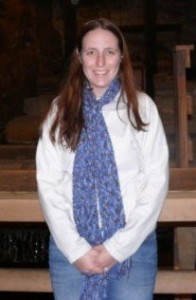Science on the Half Sphere’s first full-length planetarium show is Cosmic Castaways. In this series of posts, we will talk about how the show was made. The goal is to help other people interested in making full-dome planetarium shows see what we did, and hopefully avoid our mistakes!
 In the next series of postings, we will focus on Annie Wilson, our animation guru, who did an enormous amount of work on Cosmic Castaways. Take it away Annie!
In the next series of postings, we will focus on Annie Wilson, our animation guru, who did an enormous amount of work on Cosmic Castaways. Take it away Annie!
About half of the scenes in Cosmic Castaways were rendered using Blender, which is a free and open-source 3D animation suite of programs. I don’t think it was intentional — it was more of a case of what software would be better suited for each scene. Almost all of the Blender scenes involved moving around in 3D space, 3D models or creating some sort of effect that wasn’t possible in Adobe AfterEffects.
I have a love/hate relationship with Blender. If you have the money, I strongly suggest you look into commercial alternatives such as 3ds Max, Maya, LightWave 3D, or Cinema 4D. I’ve never used any of these programs and cannot recommend one over another.
Love: Blender is great because it’s free, cross platform and open-source which makes it very customizable. There’s all sorts of resources out there to help you learn or create larger projects, most of which are free. The community is helpful even if you are a complete newbie. There’s even a Blender community specifically for planetarians, called Blendertarium!
Hate: Blender is terrible because of the lack of documentation and the constant updates. I know updating doesn’t sound like a bad thing, but if you’re in the middle of a large project the last thing you want to do is attempt to learn how a new feature works or hunt for a setting that you need to adjust. Constant updates also means that the wiki is never complete for each version. The best you can do is hope that the feature didn’t change significantly from previous versions and someone took the time to document it.
The user interface is atrocious. It probably makes sense to a professional or to someone that has worked with other 3D modelling software before, but it makes little sense to the average user. The number of menu options and buttons can be overwhelming. The tooltips aren’t always helpful. You right click to select objects which is opposite from the universal standard. Blender practically requires one hand on the keyboard and one hand on the mouse due to the overwhelming number of keyboard shortcuts — some of which aren’t even logical. A numpad isn’t technically required but it is difficult to quickly change views without it. While that’s not a problem for desktop users it is a problem for laptop users. Keyboard shortcuts are supposed to help speed up workflow but it defeats the purpose when you keep a list of shortcuts handy. Oh, and Blender can (and will) crash without notification or even an error message.
Even with all of that, Blender is pretty powerful. If you know how to use it you can get fairly photorealistic scenes. Advanced users wanting even more photorealism in their stills will use another program to render and may use Photoshop for post-processing.
Cherry Blossom by Andrew Price (BlenderGuru), before post-processing
Cherry Blossom by Andrew Price, after post-processing
And if you don’t know what you’re doing, it’s not going to be very pretty.
Sunset on alien world (early version) by Annie Wilson
Next up: General advice on using Blender and rendering
No comments yet.